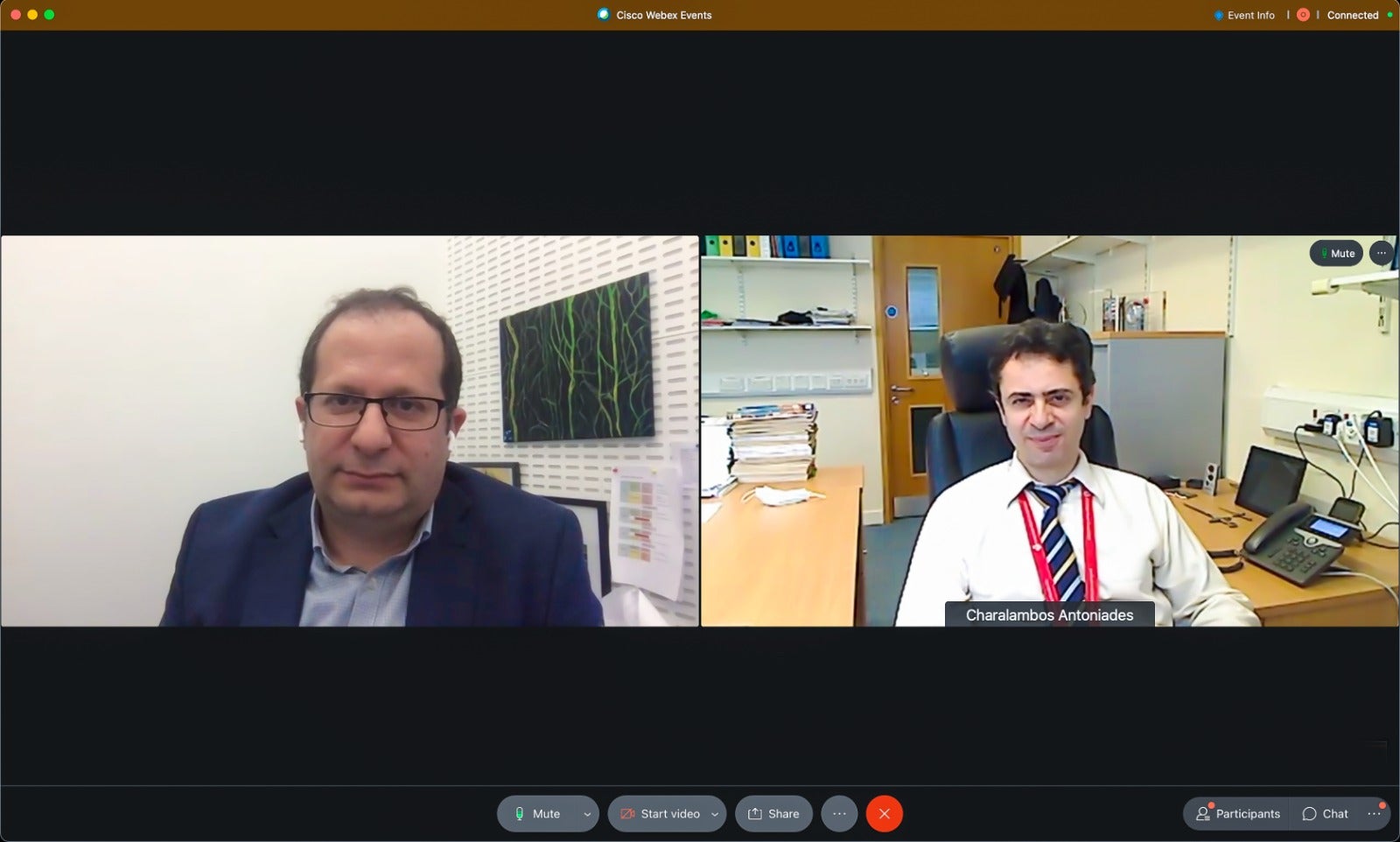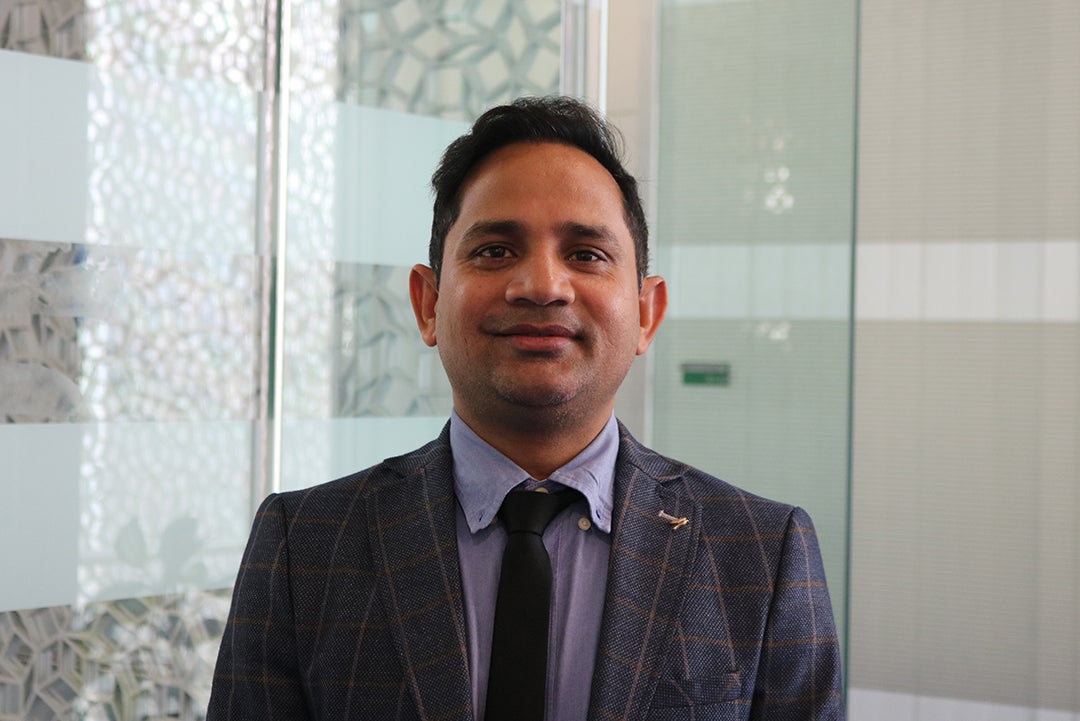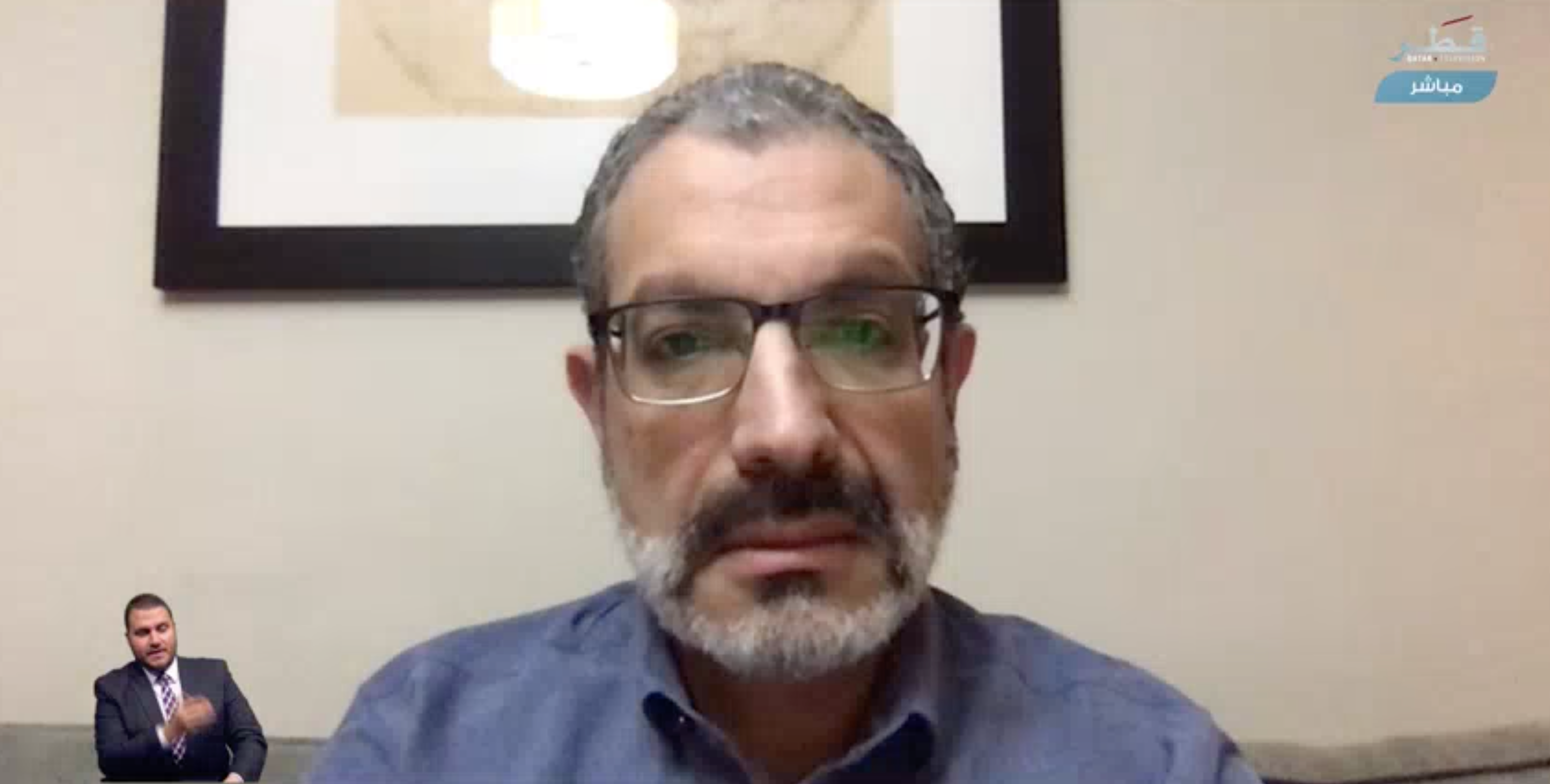
How to Return to a Regular Exercise Routine After COVID-19
The pandemic has led to many residents decreasing - or even stopping physical activity - but as Qatar celebrates National Sport Day, Dr. Nathan Townsend and Dr. Hend Mansoor of the College of Health and Life Sciences at Hamad Bin Khalifa University provide advice for getting back into shape

Since the onset of the COVID-19 pandemic, many aspects of our routine daily activities have changed, especially early on during the lockdown. Now, we are adapting to the “new normal” which still involves some changes to our routine. For example, we are practicing social distancing, wearing masks has become almost universal outdoors, and there is a limit on the number of people allowed at most indoor facilities.
These restrictions may continue until Qatar reaches a sufficient level of herd immunity through the use of a vaccine. Globally, the social distancing restrictions have led to an overall decrease in the amount of physical activity that is occurring and this may lead to de-training or an even more sedentary lifestyle than prior to the pandemic.
Therefore, an important aspect that Qatari residents need to focus on is maintaining or returning to their previous level of physical activity or starting a new exercise routine for those who were not regularly exercising before the pandemic.
It is well known that regular physical activity has numerous health benefits including cardiovascular, respiratory, metabolic, and mental health, as well as the sense of well-being. International societies such as the American Heart Association, the American College of Sport Medicine (ACSM), and the UK National Health Service recommend at least 150 minutes of moderate-intensity physical activity (where the breathing rate increases but the person can talk comfortably, such as brisk walking) or 75 minutes of vigorous physical activity (where the breathing rate increases but it is difficult to talk, such as running) per week plus two days of muscle strength training.
 The pleasant outdoor weather during Qatar’s winter provides a great time to resume or start regular physical activity because this allows individuals to exercise without the need to remain indoors in an air-conditioned environment.
The pleasant outdoor weather during Qatar’s winter provides a great time to resume or start regular physical activity because this allows individuals to exercise without the need to remain indoors in an air-conditioned environment.
For many people with busy lifestyles, 150 minutes plus two days of resistance training per week might seem difficult to achieve. However, it should be noted that epidemiological research indicates that a larger proportion of the benefits of regular physical activity on reducing the risk of cardiometabolic diseases occurs when shifting from no exercise (or almost none) to only a small amount per week, for example, 60 minutes of moderate-intensity activity - even though this is well below the recommended weekly guidelines.
The adage “something is better than nothing” really does apply in this case, and therefore it is better to do some exercise, instead of none, even if you cannot meet the recommended guidelines.
In fact, it is not advisable to go straight into 75 minutes per week of vigorous-intensity activity for most sedentary people, and particularly those with underlying health conditions or injuries should not commence with vigorous-intensity exercise. Also, since many of us may have reduced our physical activity level during the lockdown period, then it is definitely recommended even for otherwise healthy individuals to gradually resume physical activity until reaching a similar level as achieved prior to the lockdown.
Similarly, for those individuals unaccustomed to regular exercise, it is always recommended to commence exercise gradually, rather than suddenly using high- intensity training methods. Note also in this case, the guidelines of starting, or returning to, regular exercise gradually is consistent with the recommendation that “something is better than nothing”. It is best to start easy and establish a routine even if you do not meet the ACSM weekly targets, and then build up over time. Just getting started will provide benefits!
For older individuals and/or those suffering from chronic conditions, it is advisable to seek clearance for exercise from their primary care physicians prior to resuming their routine physical activity. If you are at all unsure about your risk category for exercise, then you can self-administer an internationally recognized physical activity screening tool such as the 2018 ACSM Exercise Prescreening Chart (aka Risk Stratification, aka Risk Classification), or the 2020 The Physical Activity Readiness Questionnaire for Everyone (2020 PAR-Q+). These screening tools offer useful guidance on whether or not you should seek prior medical clearance to exercise from a physician.
Lastly, for patients who suffered from COVID-19, these recommendations might differ since we are still understanding more about the consequences of the disease. If they had a mild form of the disease and did not require hospitalization, experts recommend that these patients could resume physical activity after seven days of being asymptomatic.
For patients who had a more severe form of the disease or required hospitalization, they need to be evaluated by their primary care physician prior to resuming physical activity since these patients might have abnormalities to the heart (called myocarditis) or blood clots in the lungs (called pulmonary embolism).
Once their physician believes that they are safe to resume physical activity, experts recommend resuming physical activity in graded stages. If the individual feels comfortable and without symptoms for one week, they can move to the next stage.
Dr. Nathan Towsend and Dr. Hend Mansoor are assistant professors at the College of Health and Life Sciences at Hamad Bin Khalifa University.
Related News

HBKU Participates at Sidra Medicine’s 9th Precision Medicine and Functional Genomics Conference

Doctorate Student at HBKU’s College of Health and Life Sciences Receives Specialist Author Award

CHLS Presents Webinar on Advances in Early Detection of Heart and Brain Diseases

Vaccination is Vital Not Only for Individual Health but Also to Thwart the Pandemic

College of Health and Life Sciences Highlights Graduate Degree Programs at Virtual Information Session

HBKU’s College of Health and Life Sciences Highlights Potential New Applications for Selective Enzyme Inhibitors in Leading Journal

HBKU’s College of Health and Life Science Highlights Potential for Research Exchange at Qatar-Poland Roundtable

HBKU’s College of Health and Life Sciences Collaborates on Computational Analysis for Potential Drug Repurposing

HBKU’s College of Health and Life Sciences Participates at Sidra Medicine's Precision Medicine and Functional Genomics Symposium

HBKU’s College of Health and Life Sciences Organizes Single-Cell Genomics Symposium

HBKU Participates at Sidra Medicine’s 9th Precision Medicine and Functional Genomics Conference

Doctorate Student at HBKU’s College of Health and Life Sciences Receives Specialist Author Award

CHLS Presents Webinar on Advances in Early Detection of Heart and Brain Diseases

Vaccination is Vital Not Only for Individual Health but Also to Thwart the Pandemic

College of Health and Life Sciences Highlights Graduate Degree Programs at Virtual Information Session

HBKU’s College of Health and Life Sciences Highlights Potential New Applications for Selective Enzyme Inhibitors in Leading Journal

HBKU’s College of Health and Life Science Highlights Potential for Research Exchange at Qatar-Poland Roundtable

HBKU’s College of Health and Life Sciences Collaborates on Computational Analysis for Potential Drug Repurposing

HBKU’s College of Health and Life Sciences Participates at Sidra Medicine's Precision Medicine and Functional Genomics Symposium

HBKU’s College of Health and Life Sciences Organizes Single-Cell Genomics Symposium

HBKU Participates at Sidra Medicine’s 9th Precision Medicine and Functional Genomics Conference

Doctorate Student at HBKU’s College of Health and Life Sciences Receives Specialist Author Award

CHLS Presents Webinar on Advances in Early Detection of Heart and Brain Diseases

Vaccination is Vital Not Only for Individual Health but Also to Thwart the Pandemic

College of Health and Life Sciences Highlights Graduate Degree Programs at Virtual Information Session

HBKU’s College of Health and Life Sciences Highlights Potential New Applications for Selective Enzyme Inhibitors in Leading Journal

HBKU’s College of Health and Life Science Highlights Potential for Research Exchange at Qatar-Poland Roundtable

HBKU’s College of Health and Life Sciences Collaborates on Computational Analysis for Potential Drug Repurposing

HBKU’s College of Health and Life Sciences Participates at Sidra Medicine's Precision Medicine and Functional Genomics Symposium

HBKU’s College of Health and Life Sciences Organizes Single-Cell Genomics Symposium

HBKU Participates at Sidra Medicine’s 9th Precision Medicine and Functional Genomics Conference

Doctorate Student at HBKU’s College of Health and Life Sciences Receives Specialist Author Award

CHLS Presents Webinar on Advances in Early Detection of Heart and Brain Diseases

Vaccination is Vital Not Only for Individual Health but Also to Thwart the Pandemic

College of Health and Life Sciences Highlights Graduate Degree Programs at Virtual Information Session

HBKU’s College of Health and Life Sciences Highlights Potential New Applications for Selective Enzyme Inhibitors in Leading Journal

HBKU’s College of Health and Life Science Highlights Potential for Research Exchange at Qatar-Poland Roundtable

HBKU’s College of Health and Life Sciences Collaborates on Computational Analysis for Potential Drug Repurposing

HBKU’s College of Health and Life Sciences Participates at Sidra Medicine's Precision Medicine and Functional Genomics Symposium

HBKU’s College of Health and Life Sciences Organizes Single-Cell Genomics Symposium

HBKU Participates at Sidra Medicine’s 9th Precision Medicine and Functional Genomics Conference

Doctorate Student at HBKU’s College of Health and Life Sciences Receives Specialist Author Award

CHLS Presents Webinar on Advances in Early Detection of Heart and Brain Diseases

Vaccination is Vital Not Only for Individual Health but Also to Thwart the Pandemic

College of Health and Life Sciences Highlights Graduate Degree Programs at Virtual Information Session

HBKU’s College of Health and Life Sciences Highlights Potential New Applications for Selective Enzyme Inhibitors in Leading Journal

HBKU’s College of Health and Life Science Highlights Potential for Research Exchange at Qatar-Poland Roundtable

HBKU’s College of Health and Life Sciences Collaborates on Computational Analysis for Potential Drug Repurposing

HBKU’s College of Health and Life Sciences Participates at Sidra Medicine's Precision Medicine and Functional Genomics Symposium

HBKU’s College of Health and Life Sciences Organizes Single-Cell Genomics Symposium

HBKU Participates at Sidra Medicine’s 9th Precision Medicine and Functional Genomics Conference

Doctorate Student at HBKU’s College of Health and Life Sciences Receives Specialist Author Award

CHLS Presents Webinar on Advances in Early Detection of Heart and Brain Diseases

Vaccination is Vital Not Only for Individual Health but Also to Thwart the Pandemic

College of Health and Life Sciences Highlights Graduate Degree Programs at Virtual Information Session

HBKU’s College of Health and Life Sciences Highlights Potential New Applications for Selective Enzyme Inhibitors in Leading Journal

HBKU’s College of Health and Life Science Highlights Potential for Research Exchange at Qatar-Poland Roundtable

HBKU’s College of Health and Life Sciences Collaborates on Computational Analysis for Potential Drug Repurposing

HBKU’s College of Health and Life Sciences Participates at Sidra Medicine's Precision Medicine and Functional Genomics Symposium

HBKU’s College of Health and Life Sciences Organizes Single-Cell Genomics Symposium

HBKU Participates at Sidra Medicine’s 9th Precision Medicine and Functional Genomics Conference

Doctorate Student at HBKU’s College of Health and Life Sciences Receives Specialist Author Award

CHLS Presents Webinar on Advances in Early Detection of Heart and Brain Diseases

Vaccination is Vital Not Only for Individual Health but Also to Thwart the Pandemic

College of Health and Life Sciences Highlights Graduate Degree Programs at Virtual Information Session

HBKU’s College of Health and Life Sciences Highlights Potential New Applications for Selective Enzyme Inhibitors in Leading Journal

HBKU’s College of Health and Life Science Highlights Potential for Research Exchange at Qatar-Poland Roundtable

HBKU’s College of Health and Life Sciences Collaborates on Computational Analysis for Potential Drug Repurposing

HBKU’s College of Health and Life Sciences Participates at Sidra Medicine's Precision Medicine and Functional Genomics Symposium

HBKU’s College of Health and Life Sciences Organizes Single-Cell Genomics Symposium

HBKU Participates at Sidra Medicine’s 9th Precision Medicine and Functional Genomics Conference

Doctorate Student at HBKU’s College of Health and Life Sciences Receives Specialist Author Award

CHLS Presents Webinar on Advances in Early Detection of Heart and Brain Diseases

Vaccination is Vital Not Only for Individual Health but Also to Thwart the Pandemic

College of Health and Life Sciences Highlights Graduate Degree Programs at Virtual Information Session

HBKU’s College of Health and Life Sciences Highlights Potential New Applications for Selective Enzyme Inhibitors in Leading Journal

HBKU’s College of Health and Life Science Highlights Potential for Research Exchange at Qatar-Poland Roundtable

HBKU’s College of Health and Life Sciences Collaborates on Computational Analysis for Potential Drug Repurposing

HBKU’s College of Health and Life Sciences Participates at Sidra Medicine's Precision Medicine and Functional Genomics Symposium

HBKU’s College of Health and Life Sciences Organizes Single-Cell Genomics Symposium

HBKU Participates at Sidra Medicine’s 9th Precision Medicine and Functional Genomics Conference

Doctorate Student at HBKU’s College of Health and Life Sciences Receives Specialist Author Award

CHLS Presents Webinar on Advances in Early Detection of Heart and Brain Diseases

Vaccination is Vital Not Only for Individual Health but Also to Thwart the Pandemic

College of Health and Life Sciences Highlights Graduate Degree Programs at Virtual Information Session

HBKU’s College of Health and Life Sciences Highlights Potential New Applications for Selective Enzyme Inhibitors in Leading Journal

HBKU’s College of Health and Life Science Highlights Potential for Research Exchange at Qatar-Poland Roundtable

HBKU’s College of Health and Life Sciences Collaborates on Computational Analysis for Potential Drug Repurposing

HBKU’s College of Health and Life Sciences Participates at Sidra Medicine's Precision Medicine and Functional Genomics Symposium

HBKU’s College of Health and Life Sciences Organizes Single-Cell Genomics Symposium

HBKU Participates at Sidra Medicine’s 9th Precision Medicine and Functional Genomics Conference

Doctorate Student at HBKU’s College of Health and Life Sciences Receives Specialist Author Award

CHLS Presents Webinar on Advances in Early Detection of Heart and Brain Diseases

Vaccination is Vital Not Only for Individual Health but Also to Thwart the Pandemic

College of Health and Life Sciences Highlights Graduate Degree Programs at Virtual Information Session

HBKU’s College of Health and Life Sciences Highlights Potential New Applications for Selective Enzyme Inhibitors in Leading Journal

HBKU’s College of Health and Life Science Highlights Potential for Research Exchange at Qatar-Poland Roundtable

HBKU’s College of Health and Life Sciences Collaborates on Computational Analysis for Potential Drug Repurposing

HBKU’s College of Health and Life Sciences Participates at Sidra Medicine's Precision Medicine and Functional Genomics Symposium

HBKU’s College of Health and Life Sciences Organizes Single-Cell Genomics Symposium

HBKU Participates at Sidra Medicine’s 9th Precision Medicine and Functional Genomics Conference

Doctorate Student at HBKU’s College of Health and Life Sciences Receives Specialist Author Award

CHLS Presents Webinar on Advances in Early Detection of Heart and Brain Diseases

Vaccination is Vital Not Only for Individual Health but Also to Thwart the Pandemic

College of Health and Life Sciences Highlights Graduate Degree Programs at Virtual Information Session

HBKU’s College of Health and Life Sciences Highlights Potential New Applications for Selective Enzyme Inhibitors in Leading Journal

HBKU’s College of Health and Life Science Highlights Potential for Research Exchange at Qatar-Poland Roundtable

HBKU’s College of Health and Life Sciences Collaborates on Computational Analysis for Potential Drug Repurposing

HBKU’s College of Health and Life Sciences Participates at Sidra Medicine's Precision Medicine and Functional Genomics Symposium

HBKU’s College of Health and Life Sciences Organizes Single-Cell Genomics Symposium

HBKU Participates at Sidra Medicine’s 9th Precision Medicine and Functional Genomics Conference

Doctorate Student at HBKU’s College of Health and Life Sciences Receives Specialist Author Award

CHLS Presents Webinar on Advances in Early Detection of Heart and Brain Diseases

Vaccination is Vital Not Only for Individual Health but Also to Thwart the Pandemic

College of Health and Life Sciences Highlights Graduate Degree Programs at Virtual Information Session

HBKU’s College of Health and Life Sciences Highlights Potential New Applications for Selective Enzyme Inhibitors in Leading Journal

HBKU’s College of Health and Life Science Highlights Potential for Research Exchange at Qatar-Poland Roundtable

HBKU’s College of Health and Life Sciences Collaborates on Computational Analysis for Potential Drug Repurposing

HBKU’s College of Health and Life Sciences Participates at Sidra Medicine's Precision Medicine and Functional Genomics Symposium

HBKU’s College of Health and Life Sciences Organizes Single-Cell Genomics Symposium

HBKU Participates at Sidra Medicine’s 9th Precision Medicine and Functional Genomics Conference

Doctorate Student at HBKU’s College of Health and Life Sciences Receives Specialist Author Award

CHLS Presents Webinar on Advances in Early Detection of Heart and Brain Diseases

Vaccination is Vital Not Only for Individual Health but Also to Thwart the Pandemic

College of Health and Life Sciences Highlights Graduate Degree Programs at Virtual Information Session

HBKU’s College of Health and Life Sciences Highlights Potential New Applications for Selective Enzyme Inhibitors in Leading Journal

HBKU’s College of Health and Life Science Highlights Potential for Research Exchange at Qatar-Poland Roundtable

HBKU’s College of Health and Life Sciences Collaborates on Computational Analysis for Potential Drug Repurposing

HBKU’s College of Health and Life Sciences Participates at Sidra Medicine's Precision Medicine and Functional Genomics Symposium

HBKU’s College of Health and Life Sciences Organizes Single-Cell Genomics Symposium

HBKU Participates at Sidra Medicine’s 9th Precision Medicine and Functional Genomics Conference

Doctorate Student at HBKU’s College of Health and Life Sciences Receives Specialist Author Award

CHLS Presents Webinar on Advances in Early Detection of Heart and Brain Diseases

Vaccination is Vital Not Only for Individual Health but Also to Thwart the Pandemic

College of Health and Life Sciences Highlights Graduate Degree Programs at Virtual Information Session

HBKU’s College of Health and Life Sciences Highlights Potential New Applications for Selective Enzyme Inhibitors in Leading Journal

HBKU’s College of Health and Life Science Highlights Potential for Research Exchange at Qatar-Poland Roundtable

HBKU’s College of Health and Life Sciences Collaborates on Computational Analysis for Potential Drug Repurposing

HBKU’s College of Health and Life Sciences Participates at Sidra Medicine's Precision Medicine and Functional Genomics Symposium

HBKU’s College of Health and Life Sciences Organizes Single-Cell Genomics Symposium

HBKU Participates at Sidra Medicine’s 9th Precision Medicine and Functional Genomics Conference

Doctorate Student at HBKU’s College of Health and Life Sciences Receives Specialist Author Award

CHLS Presents Webinar on Advances in Early Detection of Heart and Brain Diseases

Vaccination is Vital Not Only for Individual Health but Also to Thwart the Pandemic

College of Health and Life Sciences Highlights Graduate Degree Programs at Virtual Information Session

HBKU’s College of Health and Life Sciences Highlights Potential New Applications for Selective Enzyme Inhibitors in Leading Journal

HBKU’s College of Health and Life Science Highlights Potential for Research Exchange at Qatar-Poland Roundtable

HBKU’s College of Health and Life Sciences Collaborates on Computational Analysis for Potential Drug Repurposing

HBKU’s College of Health and Life Sciences Participates at Sidra Medicine's Precision Medicine and Functional Genomics Symposium

HBKU’s College of Health and Life Sciences Organizes Single-Cell Genomics Symposium

HBKU Participates at Sidra Medicine’s 9th Precision Medicine and Functional Genomics Conference

Doctorate Student at HBKU’s College of Health and Life Sciences Receives Specialist Author Award

CHLS Presents Webinar on Advances in Early Detection of Heart and Brain Diseases

Vaccination is Vital Not Only for Individual Health but Also to Thwart the Pandemic

College of Health and Life Sciences Highlights Graduate Degree Programs at Virtual Information Session

HBKU’s College of Health and Life Sciences Highlights Potential New Applications for Selective Enzyme Inhibitors in Leading Journal

HBKU’s College of Health and Life Science Highlights Potential for Research Exchange at Qatar-Poland Roundtable

HBKU’s College of Health and Life Sciences Collaborates on Computational Analysis for Potential Drug Repurposing

HBKU’s College of Health and Life Sciences Participates at Sidra Medicine's Precision Medicine and Functional Genomics Symposium

HBKU’s College of Health and Life Sciences Organizes Single-Cell Genomics Symposium

HBKU Participates at Sidra Medicine’s 9th Precision Medicine and Functional Genomics Conference

Doctorate Student at HBKU’s College of Health and Life Sciences Receives Specialist Author Award

CHLS Presents Webinar on Advances in Early Detection of Heart and Brain Diseases

Vaccination is Vital Not Only for Individual Health but Also to Thwart the Pandemic

College of Health and Life Sciences Highlights Graduate Degree Programs at Virtual Information Session

HBKU’s College of Health and Life Sciences Highlights Potential New Applications for Selective Enzyme Inhibitors in Leading Journal

HBKU’s College of Health and Life Science Highlights Potential for Research Exchange at Qatar-Poland Roundtable

HBKU’s College of Health and Life Sciences Collaborates on Computational Analysis for Potential Drug Repurposing

HBKU’s College of Health and Life Sciences Participates at Sidra Medicine's Precision Medicine and Functional Genomics Symposium

HBKU’s College of Health and Life Sciences Organizes Single-Cell Genomics Symposium

HBKU Participates at Sidra Medicine’s 9th Precision Medicine and Functional Genomics Conference

Doctorate Student at HBKU’s College of Health and Life Sciences Receives Specialist Author Award

CHLS Presents Webinar on Advances in Early Detection of Heart and Brain Diseases

Vaccination is Vital Not Only for Individual Health but Also to Thwart the Pandemic

College of Health and Life Sciences Highlights Graduate Degree Programs at Virtual Information Session

HBKU’s College of Health and Life Sciences Highlights Potential New Applications for Selective Enzyme Inhibitors in Leading Journal

HBKU’s College of Health and Life Science Highlights Potential for Research Exchange at Qatar-Poland Roundtable

HBKU’s College of Health and Life Sciences Collaborates on Computational Analysis for Potential Drug Repurposing

HBKU’s College of Health and Life Sciences Participates at Sidra Medicine's Precision Medicine and Functional Genomics Symposium

HBKU’s College of Health and Life Sciences Organizes Single-Cell Genomics Symposium

HBKU Participates at Sidra Medicine’s 9th Precision Medicine and Functional Genomics Conference

Doctorate Student at HBKU’s College of Health and Life Sciences Receives Specialist Author Award

CHLS Presents Webinar on Advances in Early Detection of Heart and Brain Diseases

Vaccination is Vital Not Only for Individual Health but Also to Thwart the Pandemic

College of Health and Life Sciences Highlights Graduate Degree Programs at Virtual Information Session

HBKU’s College of Health and Life Sciences Highlights Potential New Applications for Selective Enzyme Inhibitors in Leading Journal

HBKU’s College of Health and Life Science Highlights Potential for Research Exchange at Qatar-Poland Roundtable

HBKU’s College of Health and Life Sciences Collaborates on Computational Analysis for Potential Drug Repurposing

HBKU’s College of Health and Life Sciences Participates at Sidra Medicine's Precision Medicine and Functional Genomics Symposium

HBKU’s College of Health and Life Sciences Organizes Single-Cell Genomics Symposium

HBKU Participates at Sidra Medicine’s 9th Precision Medicine and Functional Genomics Conference

Doctorate Student at HBKU’s College of Health and Life Sciences Receives Specialist Author Award

CHLS Presents Webinar on Advances in Early Detection of Heart and Brain Diseases

Vaccination is Vital Not Only for Individual Health but Also to Thwart the Pandemic

College of Health and Life Sciences Highlights Graduate Degree Programs at Virtual Information Session

HBKU’s College of Health and Life Sciences Highlights Potential New Applications for Selective Enzyme Inhibitors in Leading Journal

HBKU’s College of Health and Life Science Highlights Potential for Research Exchange at Qatar-Poland Roundtable

HBKU’s College of Health and Life Sciences Collaborates on Computational Analysis for Potential Drug Repurposing

HBKU’s College of Health and Life Sciences Participates at Sidra Medicine's Precision Medicine and Functional Genomics Symposium

HBKU’s College of Health and Life Sciences Organizes Single-Cell Genomics Symposium

HBKU Participates at Sidra Medicine’s 9th Precision Medicine and Functional Genomics Conference

Doctorate Student at HBKU’s College of Health and Life Sciences Receives Specialist Author Award

CHLS Presents Webinar on Advances in Early Detection of Heart and Brain Diseases

Vaccination is Vital Not Only for Individual Health but Also to Thwart the Pandemic

College of Health and Life Sciences Highlights Graduate Degree Programs at Virtual Information Session

HBKU’s College of Health and Life Sciences Highlights Potential New Applications for Selective Enzyme Inhibitors in Leading Journal

HBKU’s College of Health and Life Science Highlights Potential for Research Exchange at Qatar-Poland Roundtable

HBKU’s College of Health and Life Sciences Collaborates on Computational Analysis for Potential Drug Repurposing

HBKU’s College of Health and Life Sciences Participates at Sidra Medicine's Precision Medicine and Functional Genomics Symposium

HBKU’s College of Health and Life Sciences Organizes Single-Cell Genomics Symposium

HBKU Participates at Sidra Medicine’s 9th Precision Medicine and Functional Genomics Conference

Doctorate Student at HBKU’s College of Health and Life Sciences Receives Specialist Author Award

CHLS Presents Webinar on Advances in Early Detection of Heart and Brain Diseases

Vaccination is Vital Not Only for Individual Health but Also to Thwart the Pandemic

College of Health and Life Sciences Highlights Graduate Degree Programs at Virtual Information Session

HBKU’s College of Health and Life Sciences Highlights Potential New Applications for Selective Enzyme Inhibitors in Leading Journal

HBKU’s College of Health and Life Science Highlights Potential for Research Exchange at Qatar-Poland Roundtable

HBKU’s College of Health and Life Sciences Collaborates on Computational Analysis for Potential Drug Repurposing

HBKU’s College of Health and Life Sciences Participates at Sidra Medicine's Precision Medicine and Functional Genomics Symposium

HBKU’s College of Health and Life Sciences Organizes Single-Cell Genomics Symposium

HBKU Participates at Sidra Medicine’s 9th Precision Medicine and Functional Genomics Conference

Doctorate Student at HBKU’s College of Health and Life Sciences Receives Specialist Author Award

CHLS Presents Webinar on Advances in Early Detection of Heart and Brain Diseases

Vaccination is Vital Not Only for Individual Health but Also to Thwart the Pandemic

College of Health and Life Sciences Highlights Graduate Degree Programs at Virtual Information Session

HBKU’s College of Health and Life Sciences Highlights Potential New Applications for Selective Enzyme Inhibitors in Leading Journal

HBKU’s College of Health and Life Science Highlights Potential for Research Exchange at Qatar-Poland Roundtable

HBKU’s College of Health and Life Sciences Collaborates on Computational Analysis for Potential Drug Repurposing

HBKU’s College of Health and Life Sciences Participates at Sidra Medicine's Precision Medicine and Functional Genomics Symposium

HBKU’s College of Health and Life Sciences Organizes Single-Cell Genomics Symposium

HBKU Participates at Sidra Medicine’s 9th Precision Medicine and Functional Genomics Conference

Doctorate Student at HBKU’s College of Health and Life Sciences Receives Specialist Author Award

CHLS Presents Webinar on Advances in Early Detection of Heart and Brain Diseases

Vaccination is Vital Not Only for Individual Health but Also to Thwart the Pandemic

College of Health and Life Sciences Highlights Graduate Degree Programs at Virtual Information Session

HBKU’s College of Health and Life Sciences Highlights Potential New Applications for Selective Enzyme Inhibitors in Leading Journal

HBKU’s College of Health and Life Science Highlights Potential for Research Exchange at Qatar-Poland Roundtable

HBKU’s College of Health and Life Sciences Collaborates on Computational Analysis for Potential Drug Repurposing

HBKU’s College of Health and Life Sciences Participates at Sidra Medicine's Precision Medicine and Functional Genomics Symposium

HBKU’s College of Health and Life Sciences Organizes Single-Cell Genomics Symposium

HBKU Participates at Sidra Medicine’s 9th Precision Medicine and Functional Genomics Conference

Doctorate Student at HBKU’s College of Health and Life Sciences Receives Specialist Author Award

CHLS Presents Webinar on Advances in Early Detection of Heart and Brain Diseases

Vaccination is Vital Not Only for Individual Health but Also to Thwart the Pandemic

College of Health and Life Sciences Highlights Graduate Degree Programs at Virtual Information Session

HBKU’s College of Health and Life Sciences Highlights Potential New Applications for Selective Enzyme Inhibitors in Leading Journal

HBKU’s College of Health and Life Science Highlights Potential for Research Exchange at Qatar-Poland Roundtable

HBKU’s College of Health and Life Sciences Collaborates on Computational Analysis for Potential Drug Repurposing

HBKU’s College of Health and Life Sciences Participates at Sidra Medicine's Precision Medicine and Functional Genomics Symposium

HBKU’s College of Health and Life Sciences Organizes Single-Cell Genomics Symposium

HBKU Participates at Sidra Medicine’s 9th Precision Medicine and Functional Genomics Conference

Doctorate Student at HBKU’s College of Health and Life Sciences Receives Specialist Author Award

CHLS Presents Webinar on Advances in Early Detection of Heart and Brain Diseases

Vaccination is Vital Not Only for Individual Health but Also to Thwart the Pandemic

College of Health and Life Sciences Highlights Graduate Degree Programs at Virtual Information Session

HBKU’s College of Health and Life Sciences Highlights Potential New Applications for Selective Enzyme Inhibitors in Leading Journal

HBKU’s College of Health and Life Science Highlights Potential for Research Exchange at Qatar-Poland Roundtable

HBKU’s College of Health and Life Sciences Collaborates on Computational Analysis for Potential Drug Repurposing

HBKU’s College of Health and Life Sciences Participates at Sidra Medicine's Precision Medicine and Functional Genomics Symposium

HBKU’s College of Health and Life Sciences Organizes Single-Cell Genomics Symposium

HBKU Participates at Sidra Medicine’s 9th Precision Medicine and Functional Genomics Conference

Doctorate Student at HBKU’s College of Health and Life Sciences Receives Specialist Author Award

CHLS Presents Webinar on Advances in Early Detection of Heart and Brain Diseases

Vaccination is Vital Not Only for Individual Health but Also to Thwart the Pandemic

College of Health and Life Sciences Highlights Graduate Degree Programs at Virtual Information Session

HBKU’s College of Health and Life Sciences Highlights Potential New Applications for Selective Enzyme Inhibitors in Leading Journal

HBKU’s College of Health and Life Science Highlights Potential for Research Exchange at Qatar-Poland Roundtable

HBKU’s College of Health and Life Sciences Collaborates on Computational Analysis for Potential Drug Repurposing

HBKU’s College of Health and Life Sciences Participates at Sidra Medicine's Precision Medicine and Functional Genomics Symposium

HBKU’s College of Health and Life Sciences Organizes Single-Cell Genomics Symposium

HBKU Participates at Sidra Medicine’s 9th Precision Medicine and Functional Genomics Conference

Doctorate Student at HBKU’s College of Health and Life Sciences Receives Specialist Author Award

CHLS Presents Webinar on Advances in Early Detection of Heart and Brain Diseases

Vaccination is Vital Not Only for Individual Health but Also to Thwart the Pandemic

College of Health and Life Sciences Highlights Graduate Degree Programs at Virtual Information Session

HBKU’s College of Health and Life Sciences Highlights Potential New Applications for Selective Enzyme Inhibitors in Leading Journal

HBKU’s College of Health and Life Science Highlights Potential for Research Exchange at Qatar-Poland Roundtable

HBKU’s College of Health and Life Sciences Collaborates on Computational Analysis for Potential Drug Repurposing

HBKU’s College of Health and Life Sciences Participates at Sidra Medicine's Precision Medicine and Functional Genomics Symposium

HBKU’s College of Health and Life Sciences Organizes Single-Cell Genomics Symposium

HBKU Participates at Sidra Medicine’s 9th Precision Medicine and Functional Genomics Conference

Doctorate Student at HBKU’s College of Health and Life Sciences Receives Specialist Author Award

CHLS Presents Webinar on Advances in Early Detection of Heart and Brain Diseases

Vaccination is Vital Not Only for Individual Health but Also to Thwart the Pandemic

College of Health and Life Sciences Highlights Graduate Degree Programs at Virtual Information Session

HBKU’s College of Health and Life Sciences Highlights Potential New Applications for Selective Enzyme Inhibitors in Leading Journal

HBKU’s College of Health and Life Science Highlights Potential for Research Exchange at Qatar-Poland Roundtable

HBKU’s College of Health and Life Sciences Collaborates on Computational Analysis for Potential Drug Repurposing

HBKU’s College of Health and Life Sciences Participates at Sidra Medicine's Precision Medicine and Functional Genomics Symposium

HBKU’s College of Health and Life Sciences Organizes Single-Cell Genomics Symposium

HBKU Participates at Sidra Medicine’s 9th Precision Medicine and Functional Genomics Conference

Doctorate Student at HBKU’s College of Health and Life Sciences Receives Specialist Author Award

CHLS Presents Webinar on Advances in Early Detection of Heart and Brain Diseases

Vaccination is Vital Not Only for Individual Health but Also to Thwart the Pandemic

College of Health and Life Sciences Highlights Graduate Degree Programs at Virtual Information Session

HBKU’s College of Health and Life Sciences Highlights Potential New Applications for Selective Enzyme Inhibitors in Leading Journal

HBKU’s College of Health and Life Science Highlights Potential for Research Exchange at Qatar-Poland Roundtable

HBKU’s College of Health and Life Sciences Collaborates on Computational Analysis for Potential Drug Repurposing

HBKU’s College of Health and Life Sciences Participates at Sidra Medicine's Precision Medicine and Functional Genomics Symposium

HBKU’s College of Health and Life Sciences Organizes Single-Cell Genomics Symposium

HBKU Participates at Sidra Medicine’s 9th Precision Medicine and Functional Genomics Conference

Doctorate Student at HBKU’s College of Health and Life Sciences Receives Specialist Author Award

CHLS Presents Webinar on Advances in Early Detection of Heart and Brain Diseases

Vaccination is Vital Not Only for Individual Health but Also to Thwart the Pandemic

College of Health and Life Sciences Highlights Graduate Degree Programs at Virtual Information Session

HBKU’s College of Health and Life Sciences Highlights Potential New Applications for Selective Enzyme Inhibitors in Leading Journal

HBKU’s College of Health and Life Science Highlights Potential for Research Exchange at Qatar-Poland Roundtable

HBKU’s College of Health and Life Sciences Collaborates on Computational Analysis for Potential Drug Repurposing

HBKU’s College of Health and Life Sciences Participates at Sidra Medicine's Precision Medicine and Functional Genomics Symposium

HBKU’s College of Health and Life Sciences Organizes Single-Cell Genomics Symposium

HBKU Participates at Sidra Medicine’s 9th Precision Medicine and Functional Genomics Conference

Doctorate Student at HBKU’s College of Health and Life Sciences Receives Specialist Author Award

CHLS Presents Webinar on Advances in Early Detection of Heart and Brain Diseases

Vaccination is Vital Not Only for Individual Health but Also to Thwart the Pandemic

College of Health and Life Sciences Highlights Graduate Degree Programs at Virtual Information Session

HBKU’s College of Health and Life Sciences Highlights Potential New Applications for Selective Enzyme Inhibitors in Leading Journal

HBKU’s College of Health and Life Science Highlights Potential for Research Exchange at Qatar-Poland Roundtable

HBKU’s College of Health and Life Sciences Collaborates on Computational Analysis for Potential Drug Repurposing

HBKU’s College of Health and Life Sciences Participates at Sidra Medicine's Precision Medicine and Functional Genomics Symposium

HBKU’s College of Health and Life Sciences Organizes Single-Cell Genomics Symposium

HBKU Participates at Sidra Medicine’s 9th Precision Medicine and Functional Genomics Conference

Doctorate Student at HBKU’s College of Health and Life Sciences Receives Specialist Author Award

CHLS Presents Webinar on Advances in Early Detection of Heart and Brain Diseases

Vaccination is Vital Not Only for Individual Health but Also to Thwart the Pandemic

College of Health and Life Sciences Highlights Graduate Degree Programs at Virtual Information Session

HBKU’s College of Health and Life Sciences Highlights Potential New Applications for Selective Enzyme Inhibitors in Leading Journal

HBKU’s College of Health and Life Science Highlights Potential for Research Exchange at Qatar-Poland Roundtable

HBKU’s College of Health and Life Sciences Collaborates on Computational Analysis for Potential Drug Repurposing

HBKU’s College of Health and Life Sciences Participates at Sidra Medicine's Precision Medicine and Functional Genomics Symposium

HBKU’s College of Health and Life Sciences Organizes Single-Cell Genomics Symposium

HBKU Participates at Sidra Medicine’s 9th Precision Medicine and Functional Genomics Conference

Doctorate Student at HBKU’s College of Health and Life Sciences Receives Specialist Author Award

CHLS Presents Webinar on Advances in Early Detection of Heart and Brain Diseases

Vaccination is Vital Not Only for Individual Health but Also to Thwart the Pandemic

College of Health and Life Sciences Highlights Graduate Degree Programs at Virtual Information Session

HBKU’s College of Health and Life Sciences Highlights Potential New Applications for Selective Enzyme Inhibitors in Leading Journal

HBKU’s College of Health and Life Science Highlights Potential for Research Exchange at Qatar-Poland Roundtable

HBKU’s College of Health and Life Sciences Collaborates on Computational Analysis for Potential Drug Repurposing

HBKU’s College of Health and Life Sciences Participates at Sidra Medicine's Precision Medicine and Functional Genomics Symposium

HBKU’s College of Health and Life Sciences Organizes Single-Cell Genomics Symposium

HBKU Participates at Sidra Medicine’s 9th Precision Medicine and Functional Genomics Conference

Doctorate Student at HBKU’s College of Health and Life Sciences Receives Specialist Author Award

CHLS Presents Webinar on Advances in Early Detection of Heart and Brain Diseases

Vaccination is Vital Not Only for Individual Health but Also to Thwart the Pandemic

College of Health and Life Sciences Highlights Graduate Degree Programs at Virtual Information Session

HBKU’s College of Health and Life Sciences Highlights Potential New Applications for Selective Enzyme Inhibitors in Leading Journal

HBKU’s College of Health and Life Science Highlights Potential for Research Exchange at Qatar-Poland Roundtable

HBKU’s College of Health and Life Sciences Collaborates on Computational Analysis for Potential Drug Repurposing

HBKU’s College of Health and Life Sciences Participates at Sidra Medicine's Precision Medicine and Functional Genomics Symposium

HBKU’s College of Health and Life Sciences Organizes Single-Cell Genomics Symposium

HBKU Participates at Sidra Medicine’s 9th Precision Medicine and Functional Genomics Conference

Doctorate Student at HBKU’s College of Health and Life Sciences Receives Specialist Author Award

CHLS Presents Webinar on Advances in Early Detection of Heart and Brain Diseases

Vaccination is Vital Not Only for Individual Health but Also to Thwart the Pandemic

College of Health and Life Sciences Highlights Graduate Degree Programs at Virtual Information Session

HBKU’s College of Health and Life Sciences Highlights Potential New Applications for Selective Enzyme Inhibitors in Leading Journal

HBKU’s College of Health and Life Science Highlights Potential for Research Exchange at Qatar-Poland Roundtable

HBKU’s College of Health and Life Sciences Collaborates on Computational Analysis for Potential Drug Repurposing

HBKU’s College of Health and Life Sciences Participates at Sidra Medicine's Precision Medicine and Functional Genomics Symposium

HBKU’s College of Health and Life Sciences Organizes Single-Cell Genomics Symposium

HBKU Participates at Sidra Medicine’s 9th Precision Medicine and Functional Genomics Conference

Doctorate Student at HBKU’s College of Health and Life Sciences Receives Specialist Author Award

CHLS Presents Webinar on Advances in Early Detection of Heart and Brain Diseases

Vaccination is Vital Not Only for Individual Health but Also to Thwart the Pandemic

College of Health and Life Sciences Highlights Graduate Degree Programs at Virtual Information Session

HBKU’s College of Health and Life Sciences Highlights Potential New Applications for Selective Enzyme Inhibitors in Leading Journal

HBKU’s College of Health and Life Science Highlights Potential for Research Exchange at Qatar-Poland Roundtable

HBKU’s College of Health and Life Sciences Collaborates on Computational Analysis for Potential Drug Repurposing

HBKU’s College of Health and Life Sciences Participates at Sidra Medicine's Precision Medicine and Functional Genomics Symposium

HBKU’s College of Health and Life Sciences Organizes Single-Cell Genomics Symposium

HBKU Participates at Sidra Medicine’s 9th Precision Medicine and Functional Genomics Conference

Doctorate Student at HBKU’s College of Health and Life Sciences Receives Specialist Author Award

CHLS Presents Webinar on Advances in Early Detection of Heart and Brain Diseases

Vaccination is Vital Not Only for Individual Health but Also to Thwart the Pandemic

College of Health and Life Sciences Highlights Graduate Degree Programs at Virtual Information Session

HBKU’s College of Health and Life Sciences Highlights Potential New Applications for Selective Enzyme Inhibitors in Leading Journal

HBKU’s College of Health and Life Science Highlights Potential for Research Exchange at Qatar-Poland Roundtable

HBKU’s College of Health and Life Sciences Collaborates on Computational Analysis for Potential Drug Repurposing

HBKU’s College of Health and Life Sciences Participates at Sidra Medicine's Precision Medicine and Functional Genomics Symposium

HBKU’s College of Health and Life Sciences Organizes Single-Cell Genomics Symposium

HBKU Participates at Sidra Medicine’s 9th Precision Medicine and Functional Genomics Conference

Doctorate Student at HBKU’s College of Health and Life Sciences Receives Specialist Author Award

CHLS Presents Webinar on Advances in Early Detection of Heart and Brain Diseases

Vaccination is Vital Not Only for Individual Health but Also to Thwart the Pandemic

College of Health and Life Sciences Highlights Graduate Degree Programs at Virtual Information Session

HBKU’s College of Health and Life Sciences Highlights Potential New Applications for Selective Enzyme Inhibitors in Leading Journal

HBKU’s College of Health and Life Science Highlights Potential for Research Exchange at Qatar-Poland Roundtable

HBKU’s College of Health and Life Sciences Collaborates on Computational Analysis for Potential Drug Repurposing

HBKU’s College of Health and Life Sciences Participates at Sidra Medicine's Precision Medicine and Functional Genomics Symposium

HBKU’s College of Health and Life Sciences Organizes Single-Cell Genomics Symposium

HBKU Participates at Sidra Medicine’s 9th Precision Medicine and Functional Genomics Conference

Doctorate Student at HBKU’s College of Health and Life Sciences Receives Specialist Author Award

CHLS Presents Webinar on Advances in Early Detection of Heart and Brain Diseases

Vaccination is Vital Not Only for Individual Health but Also to Thwart the Pandemic

College of Health and Life Sciences Highlights Graduate Degree Programs at Virtual Information Session

HBKU’s College of Health and Life Sciences Highlights Potential New Applications for Selective Enzyme Inhibitors in Leading Journal

HBKU’s College of Health and Life Science Highlights Potential for Research Exchange at Qatar-Poland Roundtable

HBKU’s College of Health and Life Sciences Collaborates on Computational Analysis for Potential Drug Repurposing

HBKU’s College of Health and Life Sciences Participates at Sidra Medicine's Precision Medicine and Functional Genomics Symposium















